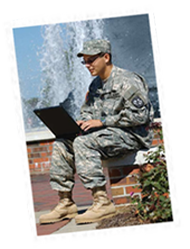







Instructors should provide students with deadlines and guidelines for participating on the discussion board. Military students often work long hours, have families, and face many other responsibilities. They often have to find time to do their schoolwork in the late hours of the night or during breaks. So, scheduling students' visits to the discussion board encourages the collaboration and interaction among discussion board groups. On their own, students will often think that they do not have time to visit the discussion board, read others' postings, and provide a quality response, so when the instructor schedules that time for the student, he or she often enters the discussion board group with a clear and open mind.
Guidelines also aid the students in understanding the assignment requirements and teacher expectations. There are many possible guidelines and ways to present them to the students. Here is one possible way to present the guidelines to the student after the question has been posted. These guidelines clarify the expectations for their postings. Instructors may also provide "unspoken" guidelines by participating in the discussion board groups' collaboration. Instructor participation may ask students "tell me more" questions that encourage students to think deeper and in new directions. Sometimes, instructor participation limits student conversation and collaboration, so it is not essential to successful student collaboration and participation.
Discussion board guidelines
The discussion board is an area in which students can both interact and exchange ideas. The discussion board allows for discussion of the various assigned topics, with the intent that this engagement will lead to further critical thinking and argument development. There are two different groups of discussion board examples provided in this section: student postings with instructor interaction to encourage more critical thinking, and student postings without any instructor interaction. The provided examples are from the various discussion board assignments students completed in conjunction with the assigned writing assignments, either from the course I developed and taught or from those taught by instructors who used the course I developed.
I developed the discussion board guidelines based on my own previous experiences with implementing this form of assignment. I have found that in order to have students consider the aspects of a given topic, there is great value in placing a minimum word count for the posting. Many students go well beyond the minimum count, but there are others that will just post a few sentences in order to say that they completed the assignment. I have found that I receive postings that are better developed with the minimum word count. As instructors we would hope our students would not need to be reminded to edit anything they submit, but I do believe the reminder provides for a better quality of work. After a few experiences with situations in which someone posted thoughts that were offensive to others, I realized that reminding students about the uses of respect and positive feedback when posting helped them maintain critical awareness of their own rhetorical choices. These reminders about being respectful and providing positive feedback also seemed to help readers be more tolerant of others’ postings.
The study from which I derived these findings is a component of a broader study investigating the uses of social presence in the online composition classroom in relation to students’ exhibition of critical thinking and argument development. Here, I have provided examples of discussion board threads in which instructors participated in the students’ interactions, and I have also included those in which the instructors did not participate. One aspect of the study was in determining whether instructors’ training in the use of social presence would enhance the students’ critical thinking and argument development in their discussion board responses. I have provided examples in which students were more aware of their instructor’s presence in the class and those in which the instructor did not participate in the discussion in order to suggest that in many cases (though not all), an instructor’s use of social presence and interaction in the discussion usefully encouraged students to think more critically about the topics being discussed in the groups.
Discussion board examples (PDFs)
| With Instructor Participation | |
| Example 1 | |
| Example 2 | |
| Example 3 | |
| Without Instructor Participation | |
| Example 1 | |
| Example 2 | |
| Example 3 | |
The use of social presence cues by the instructor, and ultimately even the students, may create a more collaborative and interactive environment. As discussed in the Pre-ops section, the use of social presence cues makes the participants seem more like real people rather than just words on a screen. Addressing people by name, sharing personal stories, and using emoticons like smiley faces are just a few of the ways that instructors and students can make themselves seem more real in their online community.